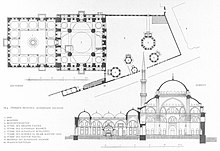Şehzade Mosque
The Şehzade Mosque ( Turkish Şehzade Camii , from the Persian شاهزاده Šāhzādeh , German prince ) is an Ottoman mosque from the 16th century in the Istanbul district of Fatih . It was built on behalf of Suleyman I in memory of his son Mehmed , who died in 1543.
history
The construction of the mosque and the Külliye was commissioned by the Ottoman Sultan Suleyman I in memory of his favorite son Mehmed (* 1521), who died on his way back to Istanbul in 1543 after a battle in Hungary. The Şehzade was the eldest son of Suleyman I and his wife Roxelane . Although Mehmed was not the sultan's eldest son, he was considered a pretender to the throne. Suleyman is said to have mourned the grave for 40 days. The Sultan commissioned the court architect Sinan to build a mausoleum and a mosque complex. It was the first major commission from the architect who planned and executed the building between 1543 and 1548.
The windows of the mosque were damaged in the bomb attack in Istanbul on June 7, 2016 .
architecture
One enters the mosque via a forecourt paved with marble slabs, the size of which corresponds to the base of the mosque. The courtyard is framed by an open portico with five domes on each side. The columns are made of alternating white and pink marble. In the center there is a Şadirvan for ritual ablutions , which Sultan Murat IV later donated. The two minarets have two circumferential galleries with geometric reliefs and terracotta inlays.
The mosque has a square plan and is spanned by a central dome, which is accompanied by four semi-domes. The dome is supported by four pillars, has a diameter of 19 meters and a height of 37 meters. The Şehzade Mosque was Sinan's first mosque, in which he placed colonnade galleries in front of the entire north and south facade to hide the supporting pillars. The interior of the mosque is architecturally simple, there are no galleries.

complex
The mosque complex consists of the mosque, Prince Mehmed's Türbe , which was completed before the mosque was built, two madrasahs , a soup kitchen and a caravanserai . The mosque and the courtyard are separated from the rest of the complex by a wall.
Mausoleums
To the south of the mosque complex is a garden with five doors. The oldest and largest of the mausoleums belongs to Prince Mehmed. At the entrance there is a Persian inscription with the date 1543-4. The mausoleum was built over an octagonal floor plan with a fluted dome, colored stone carvings and a three-arched portico . The walls inside are lined with colored Cuerda seca faience and the windows are decorated with stained glass. It is not exactly clear where the tiles come from. It is assumed, however, that these do not come from İznik , as some scientists assume, but were made in Istanbul in the first half of the 16th century. The rectangular wooden throne above the sarcophagus, symbolizing the prince's status as heir to the throne, is unusual. The mausoleum also houses the graves of Mehmed's daughter Hümaşah Sultan and that of his younger brother Cihangir († 1553). The identity of the person buried in a fourth sarcophagus is unknown.
To the south of the Şehzade mausoleum there is another smaller octagonal Türbe of the Grand Vizier Riistem Pascha , which Sinan also designed. The inscription dates to the Islamic year 968 (1560/61). Rustem Pascha was the husband of Mihrimah Sultan , daughter of Suleyman I. Like the Rustem Pascha Mosque , the Türbe is decorated with a large number of İznik ceramic tiles . At the entrance to the complex is the doorway of the Grand Vizier Damat İbrahim Pasha , the son-in-law of Murad III. who died in 1603. The tomb was designed by the architect Dalgıç Ahmed Çavuş and is very similar to that of the prince. A smaller Türbe belongs to Süleyman's sister Hatice Sultan .
literature
- Aptullah Kuran: Sinan: The grand old master of Ottoman architecture . Ada Press Publishers, 1987, ISBN 0-941469-00-X
- Suraiyah Faroqhi: Subjects of the Sultan: Culture and Daily Life in the Ottoman Empire . IB Tauris, 2005, ISBN 1-85043-760-2
- JM Rogers: Sinan: Makers of Islamic Civilization . IB Tauris, 2007, ISBN 1-84511-096-X
Web links
- Şehzade Külliyesi , Archnet
Individual evidence
- ↑ a b c Gülrü Necipoğlu: From International Timurid to Ottoman: a change of taste in sixteenth-century ceramic tiles . Muqarnas, EJ Brill, Volume 7, Leiden 1990, pp. 136-170 ( digitized version ) JSTOR 1523126
- ↑ a b c d e Gülrü Necipoğlu: The Age of Sinan: Architectural Culture in the Ottoman Empire . Reaction Books, London 2005, ISBN 978-1-86189-253-9
- ^ A b Godfrey Goodwin: A History of Ottoman Architecture . Thames & Hudson, London 2003, ISBN 978-0-500-51192-3
- ^ John Carswell: Iznik Pottery . British Museum Press, London 2006, ISBN 978-0-7141-2441-4
Coordinates: 41 ° 0 ′ 49 ″ N , 28 ° 57 ′ 26.6 ″ E





